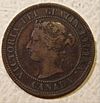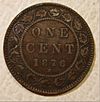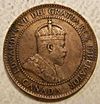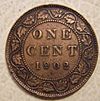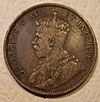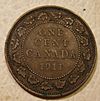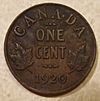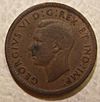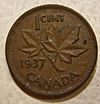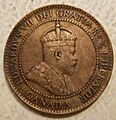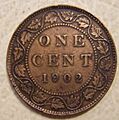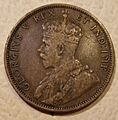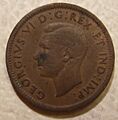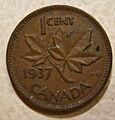Penny (Canadian coin) facts for kids
| Canada | |
| Value | 0.01 CAD |
|---|---|
| Mass | 2.35 g |
| Diameter | 19.05 mm |
| Thickness | 1.45 mm |
| Edge | Smooth |
| Composition | |
| Years of minting | 1858–2012 |
| Catalog number | CC 20 |
| Obverse | |
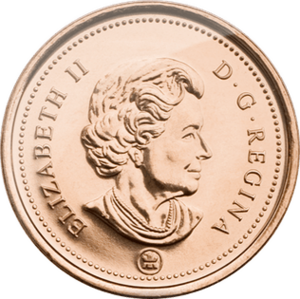 |
|
| Design | Elizabeth II, Queen of Canada |
| Designer | Susanna Blunt |
| Design date | 2003 |
| Design discontinued | 2013 |
| Reverse | |
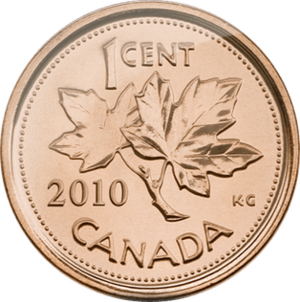 |
|
| Design | Maple leaf branch |
| Designer | G.E. Kruger Gray |
| Design date | 1937 |
| Design discontinued | 2013 |
The Canadian penny was a coin made in Canada from 1858 to 2012. It was worth one cent, which is one hundredth (1/100) of a dollar. Even though its official name was the one-cent piece by the Royal Canadian Mint, most people called it a penny or a cent. The name "penny" probably came from the British money system used in Canada before 1858, which included pounds, shillings, and pence.
In Canadian French, the penny is often called cent. Sometimes, people use slang terms like cenne, cenne noire, or sou noir (black penny). In Quebec, it's common to hear it called sou.
The Royal Canadian Mint stopped making pennies in May 2012. They also stopped giving them out on February 4, 2013. Even though new pennies are not made or given out, the coins you might still have are still considered legal money. This means they can still be used for payments. However, stores are not expected to give pennies back as change for cash payments anymore. Instead, they are encouraged to round the total cost of purchases to the nearest five cents. If you pay with a credit card or debit card, the exact amount, including cents, is still charged.
Contents
What the Canadian Penny Looks Like
Like all Canadian coins, the front side (called the obverse) of the penny showed the picture of the reigning Canadian monarch. The last design featured Queen Elizabeth II. Her picture was first used in 1953 and was updated three times. The last update was in 2003, designed by Susanna Blunt.
The back side (called the reverse) of the penny usually showed a maple leaf branch. In 1967, a special penny was made for Canada's 100th birthday. It showed a rock dove (a type of bird) and was designed by Alex Colville. This was the only time the maple leaf design wasn't used before the penny was stopped in 2012. Interestingly, the maple twig on the coin isn't exactly like a real maple tree branch. Real maple leaves grow in pairs opposite each other, but the leaves on the coin's twig are shown growing one after another.
Most pennies have a smooth, round edge. However, pennies made between 1982 and 1996 were twelve-sided. This special shape helped people who couldn't see well to tell the coin apart by touch. But when the coin's material changed in 1997, it was hard to make the twelve-sided shape with the new metal. So, the mint went back to making round pennies.
The Penny's Journey Through Time
The very first Canadian cent was made in 1858. It was quite large, about 25.4 millimeters (1 inch) across. These early cents were created to help organize Canada's money system. Before 1858, people used a mix of British coins, American coins, and even Spanish coins.
These first cents were heavier than some other small coins used at the time. This made them less popular at first. New cents weren't needed again until 1876. The large cents made from 1858 to 1920 were much bigger than the pennies we know today. They were even a bit larger than a modern Canadian 25-cent coin! In 1920, the penny was made smaller, closer to the size of the American penny.
The Rare 1936 Dot Cent
One very special and rare Canadian penny is the 1936 dot cent. Only four of these coins were ever made. They have a tiny dot on them to show they were actually produced in 1937. This happened because there was a delay in making new coin designs for King George VI after King Edward VIII gave up his throne.
One of these rare coins was sold in 2010 for over $400,000! Three of the known coins are owned by private collectors. The fourth one is not in the Ottawa Currency Museum, making it one of the few missing pieces in their collection.
The 1947 Maple Leaf Penny
Unlike the rare 1936 dot cents, the 1948 pennies that are dated 1947 and have a special mark are quite common. These 1947 Maple Leaf coins were made because the coin designs needed to be updated. The update was to remove the title "Emperor of India" from King George VI's official titles, as India had gained independence.
What Pennies Were Made Of
The materials used to make the Canadian penny changed over the years. Here's a look at how its composition changed:
| Years | Mass | Diameter/shape | Composition |
|---|---|---|---|
| 1858–1859 | 4.54 g | 25.4 mm (1 inch), round | 95% copper, 4% tin, 1% zinc (bronze) |
| 1876–1920 | 5.67 g | 25.4 mm (1 inch), round | 95.5% copper, 3% tin, 1.5% zinc |
| 1920–1941 | 3.24 g | 19.05 mm (3⁄4 inch), round | 95.5% copper, 3% tin, 1.5% zinc |
| 1942–1977 | 3.24 g | 19.05 mm (3⁄4 inch), round | 98% copper, 0.5% tin, 1.5% zinc |
| 1978–1979 | 3.24 g | 19.05 mm (3⁄4 inch), round | 98% copper, 1.75% tin, 0.25% zinc |
| 1980–1981 | 2.8 g | 19.05 mm (3⁄4 inch), round | 98% copper, 1.75% tin, 0.25% zinc |
| 1982–1996 | 2.5 g | 19.05 mm (3⁄4 inch), 12-sided | 98% copper, 1.75% tin, 0.25% zinc |
| 1997–1999 | 2.25 g | 19.05 mm (3⁄4 inch), round | 98.4% zinc, 1.6% copper plating |
| 2000–2012 | 2.35 g | 19.05 mm (3⁄4 inch), round | 94% steel, 1.5% nickel, 4.5% copper plating |
Only pennies made from 1982 until they were stopped in 2013 are still considered "circulation coins" by law. From 2006 to 2008, many older Canadian pennies (from 1942 to 1996) were actually worth more than one cent because the price of copper, the metal they were made of, went up a lot. This meant the metal in the coin was worth more than the coin's face value!
Why the Penny Was Stopped
For a long time, people talked about stopping the production of the penny. One big reason was the cost of making it. It actually cost more than one cent to produce a single penny! Also, people felt the penny wasn't as useful anymore because its value had gone down over time due to inflation.
In 2010, a government committee looked into the future of the penny. They suggested that the penny should be removed from circulation. They argued that after a century, the penny's value and usefulness had decreased. A survey in 2007 showed that only 37% of Canadians actually used pennies.
Even so, the government kept making a huge number of pennies each year, about 816 million. That's like 24 pennies for every Canadian! The Royal Canadian Mint had to make so many because pennies kept disappearing from circulation. People would either save them or just avoid using them. By late 2010, it was estimated that the average Canadian had about 600 pennies saved up at home, which meant they weren't being used in stores.
On March 29, 2012, the Canadian government announced that it would stop making the penny. They said it cost 1.6 cents to make each one-cent coin. The very last penny was made on May 4, 2012, at the Mint's factory in Winnipeg. This final penny was later given to the Bank of Canada Museum in Ottawa.
Existing pennies are still legal money, but they were officially taken out of circulation on February 4, 2013. The law states that a payment in one-cent coins is only legal for amounts up to twenty-five cents.
On February 4, 2013, the Mint started melting down the estimated 35 billion pennies that were in circulation. On the same day, Google even celebrated the end of the Canadian penny with a special Google Doodle on its homepage.
Now, when you pay with cash, the total bill is rounded to the nearest five cents. This rounding is done on the final total, not on each item. For example:
- If your total ends in 1 or 2 cents, it rounds down to 0.
- If it ends in 3, 4, 6, or 7 cents, it rounds to 5 cents.
- If it ends in 8 or 9 cents, it rounds up to 10 cents.
To remember the penny, the Royal Canadian Mint created special silver and gold coins and collectibles. These included a tiny gold coin, a gold-plated silver coin, a five-ounce silver coin, and a set of five silver coins.
Special Penny Editions
| Image | Year | Theme | Artist | Mintage | Notes |
|---|---|---|---|---|---|
 |
1967 | Canadian centennial | Alex Colville | 345,140,645 | Features a rock dove in flight. Dated 1867–1967. |
First Strikes
These are special coins that were among the very first made in a new series or with a new feature.
| Year | Theme | Mintage | Issue price |
|---|---|---|---|
| 2005 | First day cover | 1,799 | $14.95 |
| 2006 | With new mint mark | 5,000 | $29.95 |
Images for kids
See also
- Dei Gratia Regina, which appears abbreviated on the face of the coin


